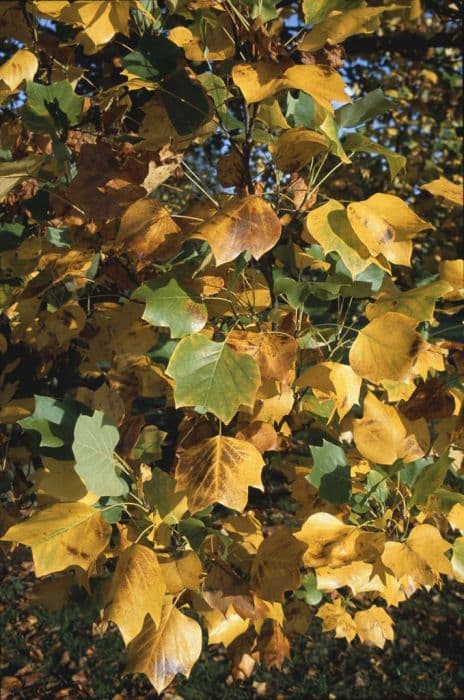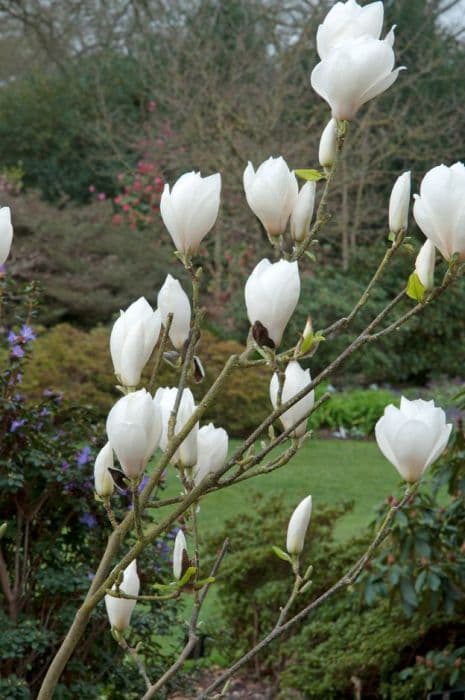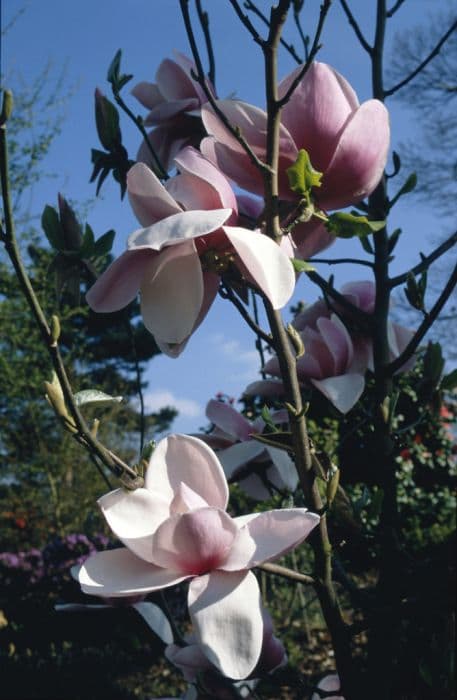Chinese magnolia Magnolia delavayi

ABOUT
Magnolia delavayi, commonly known as the Chinese evergreen magnolia, possesses a striking appearance marked by its large, glossy, deep green leaves that provide a lush backdrop to its equally impressive flowers. The leaves present a thick, leathery texture and can have a somewhat oval or oblong shape with a pointed tip, often curling slightly at the edges. The plant's flowers are particularly noteworthy and are sure to attract attention. They are large and cup-shaped, blossoming directly from the branches, sometimes appearing to be nestled amongst the dense foliage. A flower can possess a creamy-white to ivory color, with a subtle hue that suggests a touch of pink. These magnificent blooms exude a strong, sweet fragrance, making the plant not just a visual treat but also an olfactory one. Once the flowering season concludes, the plant produces cone-like fruit that displays an aggregate of pinkish-red seeds. These seeds hang on threads when mature, providing a contrast against the green foliage and adding to the plant's ornamental qualities. The overall appearance of the Chinese evergreen magnolia is one of robustness and tropical allure, with its evergreen leaves ensuring that it maintains its vibrant demeanor throughout the year. It truly is a centerpiece in any garden, conveying both elegance and a touch of the exotic.
About this plant
 Names
NamesSynonyms
Delavay's Magnolia, Chinese Evergreen Magnolia, French Magnolia
Common names
Magnolia delavayi, Yulania delavayi, Michelia delavayi, Magnolia forrestii, Magnolia liliiflora var. delavayi, Magnolia rehderiana.
 Toxicity
ToxicityTo humans
Magnolia delavayi, commonly known as the Chinese Magnolia, is not widely recognized as a toxic plant to humans. There is limited information on the toxicity of this particular species, but magnolias in general are not known for being harmful when touched or ingested. However, it is always advisable to exercise caution and avoid consuming parts of ornamental plants because individual reactions can vary, and there might be a lack of comprehensive toxicity data. If accidental ingestion occurs and any adverse reactions are noted, such as gastrointestinal discomfort or allergic reactions, it is essential to seek medical attention.
To pets
Magnolia delavayi, commonly known as the Chinese Magnolia, is typically not considered highly toxic to pets. Members of the Magnolia genus are not known for containing substances that are significantly poisonous to dogs or cats. However, ingestion of plant material can potentially cause mild gastrointestinal upset in some pets due to the novelty and fibrous nature of the material. If a pet ingests part of a Chinese Magnolia and symptoms occur, such as vomiting or diarrhea, consult with a veterinarian for appropriate care.
 Characteristics
CharacteristicsLife cycle
Perennials
Foliage type
Evergreen
Color of leaves
Green
Flower color
White
Height
12 feet [3.6 meters]
Spread
10 feet [3 meters]
Plant type
Tree
Hardiness zones
7
Native area
China
Benefits
 General Benefits
General Benefits- Landscape Ornamentation: Magnolia delavayi, commonly known as the Delavay's Magnolia, is often used in garden design for its beautiful, large white flowers which can enhance the aesthetic appeal of any landscape.
- Shade Provider: The dense foliage of the Delavay's Magnolia can offer a pleasant shade, making it a good choice for planting in parks and large gardens.
- Habitat for Wildlife: The tree provides a habitat and food source for a variety of birds and insects, contributing to biodiversity.
- Symbolic Significance: Often associated with nobility and perseverance, Delavay's Magnolia may be used in plantings to convey these characteristics.
- Aromatic Flowers: The large blossoms emit a pleasant fragrance, which can enhance the sensory experience of a garden or landscape setting.
 Medical Properties
Medical Properties- Anti-inflammatory: Magnolia delavayi has been found to contain compounds that may reduce inflammation.
- Antioxidant: It is known to possess antioxidant properties which can help in protecting the body from oxidative stress.
- Antibacterial: Extracts from this plant have been observed to exhibit antibacterial activity against certain strains of bacteria.
- Anti-cancer: There are indications that certain compounds in Magnolia delavayi might have anti-tumor properties.
- Anxiolytic: Some studies suggest that the magnolol and honokiol present in Magnolia species may have anxiolytic effects, reducing anxiety.
 Air-purifying Qualities
Air-purifying QualitiesThis plant is not specifically known for air purifying qualities.
 Other Uses
Other Uses- The bark of Magnolia delavayi can be used as a natural dye, providing hues for textiles and crafts.
- Wood from the tree is sometimes used in furniture making or woodworking projects due to its workability and grain pattern.
- Essential oils extracted from the flowers can be used in perfumery and aromatherapy for their fresh and citrusy fragrance.
- The large, sturdy leaves can be used as makeshift plates or serving platters in outdoor settings.
- Floral artists often use the magnolia's showy, aromatic blossoms in arrangements and bridal bouquets.
- The flower buds and petals of Magnolia delavayi can be candied and used as decorative, sweet garnishes on desserts.
- In landscaping, the tree is planted for its large, attractive foliage and to provide shade due to its dense canopy.
- Magnolia delavayi's robust seed cones are sometimes used in arts and crafts for their unique and interesting texture.
- The magnolia tree is often utilized in bonsai culture, creating miniature versions that echo the beauty of the full-sized tree.
- Due to its ornamental appearance, dried magnolia leaves and flowers are used in potpourri mixes.
Interesting Facts
 Feng Shui
Feng ShuiThe Chinese Magnolia is not used in Feng Shui practice.
 Zodiac Sign Compitability
Zodiac Sign CompitabilityThe Chinese Magnolia is not used in astrology practice.
 Plant Symbolism
Plant Symbolism- Purity: The magnolia's white flowers are often associated with purity and innocence.
- Dignity: The impressive appearance and stature of the magnolia tree symbolize dignity and nobility.
- Perseverance: Magnolias are known for their ability to survive challenging conditions, representing endurance and perseverance.
- Beauty: With their large, showy flowers, magnolias are commonly associated with beauty and grace.
- Femininity: The soft and delicate nature of magnolia flowers is often linked to femininity and gentleness.
- Hospitality: In some cultures, magnolias represent hospitality, welcoming, and kindness due to their expansive nature.
 Water
WaterChinese Magnolia (Magnolia delavayi) prefers consistent moisture, especially during its growing season in spring and summer. The soil should be kept moderately damp, but not waterlogged. Water the plant when the top inch of soil feels dry to the touch, which may be about once or twice a week, depending on weather conditions and soil drainage. During the hotter months, you may need to water more frequently, aiming for about 1 to 2 gallons per week for an established plant. During winter, reduce watering as the plant's growth slows down.
 Light
LightChinese Magnolia thrives best in full sun to partial shade. It should be situated in a spot where it receives at least 6 hours of direct sunlight daily, but it can also benefit from some afternoon shade in regions with very hot summers. An ideal location would provide morning sunlight with some protection from the intense afternoon sun.
 Temperature
TemperatureChinese Magnolia prefers temperate climates and is hardy from USDA zones 7 through 10. The ideal temperature range for the Chinese Magnolia is between 60 to 80 degrees Fahrenheit, but it can tolerate minimum temperatures down to around 0 degrees Fahrenheit. It may suffer if temperatures exceed 95 degrees Fahrenheit for prolonged periods.
 Pruning
PruningPrune the Chinese Magnolia during late winter or early spring before new growth starts to remove dead or diseased wood and to shape the plant. Pruning is not frequently necessary for the Chinese Magnolia, but minimal shaping helps to maintain a tidy appearance and encourages healthy growth. Prune immediately after flowering if needed to minimize disruption to the next season's blooms.
 Cleaning
CleaningAs needed
 Soil
SoilThe Chinese Evergreen Magnolia requires well-drained, fertile soil with a slightly acidic to neutral pH between 5.5 and 7. A mix of loamy soil, peat moss, and perlite or sand aids in proper drainage and nutrient retention. Ensure organic matter is abundant in the mix for optimal growth.
 Repotting
RepottingChinese Evergreen Magnolia should be repotted every 2 to 3 years or when it outgrows its current pot. Choose a container that is only slightly larger than the previous one to prevent overwatering issues.
 Humidity & Misting
Humidity & MistingChinese Evergreen Magnolia thrives in moderate to high humidity levels, ideally between 50% and 60%. If the air is too dry, the leaves may brown at the tips.
 Suitable locations
Suitable locationsIndoor
Place in bright, indirect light and keep soil moist.
Outdoor
Plant in partial shade, protect from strong winds, and mulch.
Hardiness zone
7-10 USDA
 Life cycle
Life cycleMagnolia delavayi, commonly known as the Delavay's Magnolia, begins life as a seed that germinates in the moist, rich soil typical of its native habitat in southwestern China. Following germination, the seedling grows into a juvenile plant with characteristic glossy, dark green leaves, progressively maturing into a woody shrub or small tree. The plant reaches reproductive maturity in several years, producing large white or reddish flowers that are often fragrant, attracting pollinators such as beetles. After pollination, the flowers develop into cone-like fruit aggregates that release red or orange seeds when mature. These seeds are dispersed by gravity and potentially by animals, completing the reproductive cycle. Apart from sexual reproduction, Delavay's Magnolia can also propagate vegetatively through root suckers, contributing to the establishment of new individuals in close proximity to the parent plant.
 Propogation
PropogationPropogation time
Spring-summer
Magnolia delavayi, commonly known as Chinese magnolia, is typically propagated by seed, as it is the most popular method for this species. Seed collection should occur when the fruit begins to split open, revealing the seeds. Once collected, the seeds need to be cleaned of their fleshy coating, ideally through a fermentation process or by soaking in warm water for 24 hours. Following cleaning, the seeds require stratification, which involves mixing them with moist sand and storing them at temperatures between 32-41 degrees Fahrenheit (0-5 degrees Celsius) for about 3-6 months to break dormancy. After stratification, the seeds can be sown in containers filled with well-draining soil mix, lightly covering them with soil. Germination can take several more months, and it's essential to keep the soil consistently moist but not waterlogged. Seedlings should be grown in a protected area until they are strong enough to be planted in their permanent locations.









